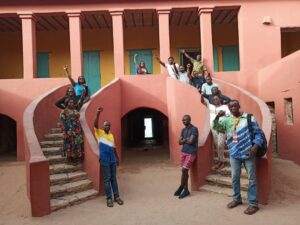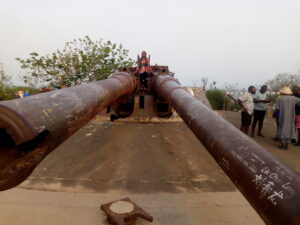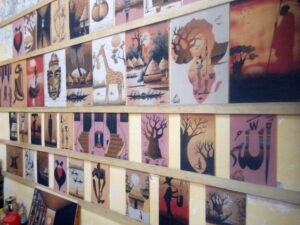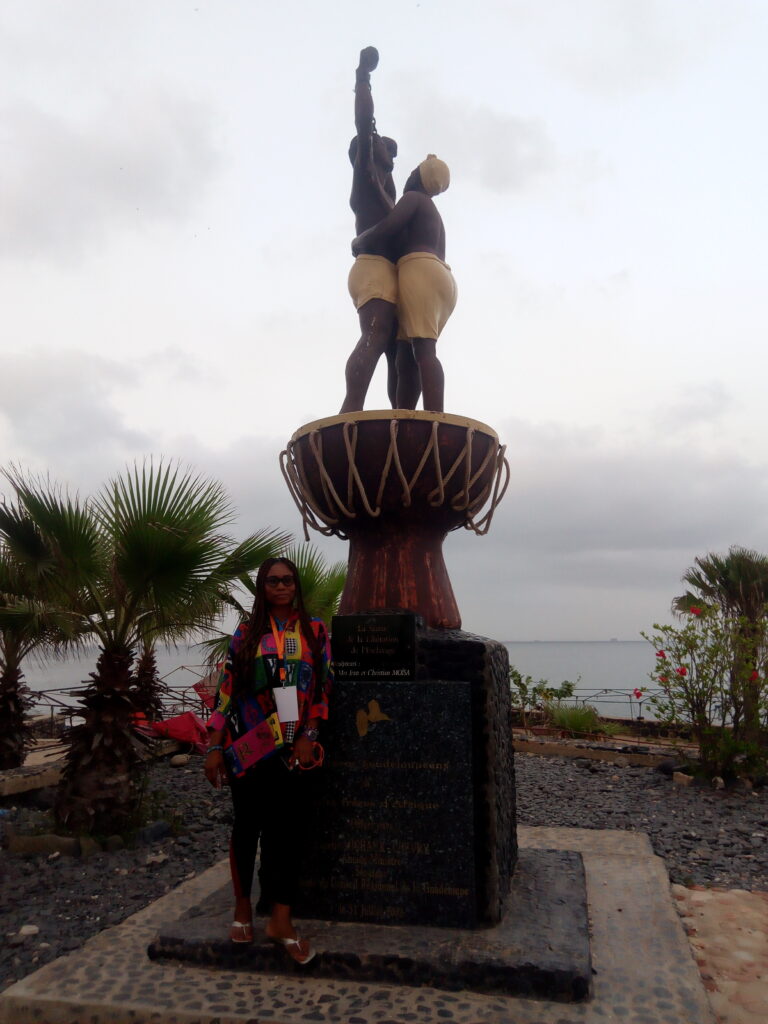Everything seems to sing and dance to the melodious redemption tune played through the land.
The song speaks the language of pains, inflicted by men who came to steal and kill.
They did not only steal and kill, but ravaged the innocent bodies of African young females, making their tender, plumpy breast sag. They sag so early!

“For fear of these masters, who enjoyed the agony of our ancestors, they seat upstairs shouting ‘Blacks are Animals! Take them away!’ They say this so often till they tend to believe and make us believe ‘we are animals’ and should be bound hand and foot in chains and taken away to sell to foreign merchants. Mental slavery was their technique,” the voice of the Tour Guide, Elijah Abubakar was laced with so much emotions as it continued to rise in historical crescendo, telling the story of the centre of African slavery, according to UNESCO.
“They decided our fates upstairs while we were downstairs starring into a bleak future.
“Fear made fathers and mothers betray their children. They became collaborators and their daughters suddenly plunged into the reality of adulthood and titled ‘Señoritas!’
“No! They never stayed with them. They ravaged their bodies and left them single and unmarried. Young ladies who eventually turn ‘baby-mamas,’ forced into human trafficking.”

The Boabab mourns through the years and dies groaning of the many sad tales its has to bear for generations. The story of man inhumanity on the shore of Senegal where world leaders now visit to witness the scars of slavery. The bruised wrists and ankles of African Ancestors which never stopped their slave masters to lead them away through the ‘Door-of-No-Return.’
Who tells their story? The Baobabs where historians are buried and their souls awakened through the traditional voodooism to whisper the past to the presence.
Where is the eerie-creepy feelings that the ancient slave buildings should exude? The place where many African slaves died in exhaustion of the pains injected into their bones. Some were drown in the sea for being too weak for labour or in refusal to sleep with their mothers for more slaves to be produced. Incest!
We arrived! The ancient buildings brought a nostalgic feeling. A relaxed one in the ambience of renaissance. Where antiquated buildings, maintain with no intention to erode its originality but sustain through local architectural skills. Few hybrid-features to indicate the presence of the white slave lords.

Like an old castle in a Romeo and Juliet story, the mustard and ochre-coloured buildings with wooden balconies and terracotta tile roofs, lined along the cobblestone footpaths, serves as vacation Island for many tourists, mostly the whites.
The ornamental flowers lined along the cobblestoned-carless footpaths give the old buildings a fairy look. Instead of slave dungeons, these buildings now house cultural artefacts of the slave story, preserved by curators. Local artists through their skillful drawings make a living from tourists who need art souvenirs to keep in touch with the history.
Crest Newspaper editor, Enwono attends workshop in Gorée Institute, Dakar-Senegal
The 1800 population, including; men, women and children living in the Island, showcase their wares including clothes, beads, art works, Baobab and other local snacks, etc. Displaying these goods in small shades and at every corner where tourists can patronise them.
Goree Island serves as a tourism monument where world leaders make pilgrim to see the ‘Sortie’ (exit) of the African ancestors who lost their roots through slavery.
No wonder Late world Leader, Anti- Apartheid Hero and the President of South Africa, Nelson Rolihlahla Mandela, after 27 years in prison could feel the pains of his brothers who were bundled into dark dungeons called ‘Slave Prisons.’
He crawled into one of the very tight stoned prison where stubborn African male slaves were broken and crawled out crying.
He understood the story more than anyone!
“Immediately the anti-apartheid hero, Nelson Mandela was released from prison, the first place he visited was this Island,” Executive Director of Goree Institute, Dou Dou Dia said.
Other world Leaders like the first African- American President of the United States, Barack Hussein Obama visited the Island in 2013, Pope John Paul II asked for forgiveness of evil perpetuated against the Africans. And many progressive discourses for the advancement of African region take place in this Island.
“The move towards the release of Nelson Mandela was first discussed in this island,” Dou Dou Dia disclosed.
When you visit Senegal and decide to take a ferry to Goree Island, don’t panic over the presence of the United State (US) Navy. That harbour harbored the history of slave trade from the 15th to 16th century where the Portuguese launched slavery. Currently, the US protects the Senegal water front serving as route for international trade and harbour for many international ferries.
So, be at peace and append your autograph too on the 360° Cannon artefact somewhere in the Island. It is decorated with so many autographs from tourists. This Cannon, the French Government used to protect and gain sovereignty over the Island from the British Colonial masters. The Tour Guide, Elijah Abubakar said the Cannon’s shooting-range was approximately 14km (9.9 miles). Portuguese ruled and thrived in slave trade on the Island for 150 years, giving way to the Dutch and later British which were overpowered by the French.
When ushered into the women’s storage room, don’t be afraid to be emotional. Feel the agony of childbirth which the African women went through against their will. In very cruel situation, they became baby factories to produce many prospective slaves to the slave masters. These children were taken and nurtured from the age of nine to be sold out at the age of twelve.
Just solemnly get a glass of clean water and conduct the water ritual by pouring a clean glass of water into the bowl where the women and babies were washed after child birth.
As you visit the Island, learn simple greetings in French and with a smile for the land had long been liberated from its slave shackles.
Maison des Esclaves is a museum built like a Dome within the Island, bearing many African artefacts to tell the story of torture, survival and victory over slavery in Goree Island.
Just in wollof, the native language of the Senegalese, be ‘jollof-jollof’ (true African) and never forget the simple gesture of gratitude.
‘Jerry-Jef!’
Note: This story can not be the comprehensive history of Goree Island, Darka – Senegal.



1 Comment
Pingback: Uyo agog as Akan Emah becomes 7th Governor of Rotary